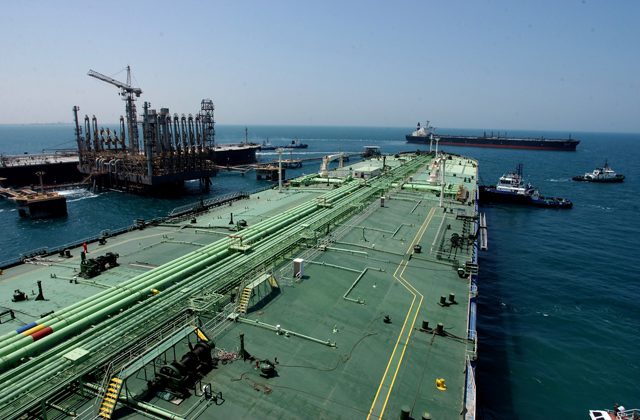Major Cocaine Bust: UK Border Force Seizes Record Shipment at London Gateway
In one of the UK’s largest drug seizures of the past decade, UK Border Force officers have seized cocaine with an estimated street value of £96 million (USD 130 million)...

A VLCC berths at our Ras Tanura Sea Island Terminal, part of the Port of Ras Tanura, the world’s largest crude oil export terminal complex. file image: Saudi Aramco
By Lananh Nguyen
Nov. 28 (Bloomberg) — Brent crude steadied after OPEC triggered the biggest one-day plunge in three years yesterday by failing to cut its output in response to a glut. Oil in New York headed for its biggest weekly drop since 2011.
Futures rose 0.3 percent in London, having fallen 9.4 percent this week. OPEC will maintain its collective output target at 30 million barrels a day, Saudi Arabia’s Oil Minister Ali Al-Naimi said after discussions in Vienna yesterday. The group’s policy will ensure a crash in the U.S. shale industry, predicted Leonid Fedun, the vice president of Russia’s OAO Lukoil.
Crude has collapsed into a bear market amid the fastest pace of U.S. production in three decades and signs of weakening global demand. OPEC wants a fair price and isn’t “sending any signals to anybody,” Secretary-General Abdalla El-Badri said. The 12-member group, which pumps 40 percent of the world’s oil, will convene again June 5 in the Austrian capital.
“The price floor has been lowered,” Olivier Jakob, managing director of researcher Petromatrix GmbH, said by phone from Paris. “Saudi Arabia was always seen as the support of last resort and it’s a signal it’s not able to react” to rising supplies, he said.
Brent for January settlement reversed an earlier loss of as much as 2 percent to trade at $72.77 a barrel on the London- based ICE Futures Europe exchange at 11:47 a.m. local time. The contract dropped $5.17 to $72.58 yesterday, the lowest close since August 2010. Total volume traded was 62 percent more than the 100-day average for the time of day. Prices have decreased 15 percent this month and 34 percent in 2014.
‘Not Angry’
WTI for January delivery declined $4.70, or 6.4 percent, to $68.99 in electronic trading on the New York Mercantile Exchange, compared with the Nov. 26 close. There was no floor trading yesterday because of the U.S. Thanksgiving holiday and transactions will be booked today for settlement purposes. Prices are down 10 percent this week.
“Welcome to the new world of oil,” Mark Keenan, the Singapore-based head of commodities research for Asia at Societe Generale SA, said by phone. “OPEC has relinquished the role of balancing the market. If they had cut production and prices had increased then they would, by definition, be losing market share. They would be encouraging and supporting further shale production. For them, short-term pain for long-term gain.”
OPEC’s decision not to reduce production creates potential for further declines in oil prices, Goldman Sachs Group Inc. said in an e-mailed report. Citing its expectation of a “large market surplus” in the first half of next year, the bank maintained its 2015 Brent forecast at $80 to $85 a barrel and WTI at $70 to $75.
Iranian Oil Minister Bijan Namdar Zanganeh said he’s “not angry” about the outcome of the talks in Vienna, even though it was “not in line with what we wanted.” OPEC isn’t “playing hardball,” according to Nigerian Petroleum Minister Diezani Alison-Madueke, who was selected as the group’s president for next year.
Market Newcomers
Conventional oil producers in OPEC can no longer dictate prices, United Arab Emirates Energy Minister Suhail Al-Mazrouei said in an interview on Nov. 26. Newcomers to the market who have the highest costs and created the glut should be the ones to determine the price, he said.
“Given the supply capacity now outside OPEC, cutting production at these levels wasn’t in the best interest of the Saudis or OPEC,” Ric Spooner, a chief strategist at CMC Markets in Sydney, said by phone. “In the medium term, somewhere in the $60s is likely to see a base, but you couldn’t discount the possibility of a short-term spike down to even lower prices.”
Ministers from Kuwait, the U.A.E. and Angola said they were concerned about the market surplus as they arrived at OPEC’s headquarters for the meeting. The group pumped 30.97 million barrels a day in October, exceeding its quota for a fifth consecutive month, data compiled by Bloomberg show.
U.S. production expanded to 9.08 million barrels a day through Nov. 21, the highest level in weekly records that started in January 1983, according to the Energy Information Administration. Crude inventories rose to 383 million, said the Energy Department’s statistical arm.
–With assistance from Ben Sharples in Melbourne.
Copyright 2014 Bloomberg.

Sign up for gCaptain’s newsletter and never miss an update

Subscribe to gCaptain Daily and stay informed with the latest global maritime and offshore news


Stay informed with the latest maritime and offshore news, delivered daily straight to your inbox
Essential news coupled with the finest maritime content sourced from across the globe.
Sign Up